|
Now for the tree I most wanted to collect, Cupressus montana (Cupressus montana) I took 4 long hiking trips to the crest of the San Pedro Martir, locating the places mentioned on that paper you sent, but could not find a trace of a Cypress tree. I must have walked 25 miles looking for it. It is difficult to hike in the area since there are almost no trails or road, and everywhere looks the same, so it's easy to get lost. I looked for the Park Forest Ranger, and he described some trees he had seen while fighting a small fire recently and they where surely Cypress trees since he described the round cones. He explained to me in spanish where he had seen them. The problem was I did not have much time since we had to be back in San Diego that night and it was already 12:30 PM and it required about a 2 hour hike to the place he described, one way, plus about 6 hour drive to San Diego, and 2 hours waiting at the border crossing. But I tried one more time even though I was already exausted from 4 hikes in two days. I hiked about 4-5km to the place he described, but did not find it exactly how he decribed it. He mentioned something about a ravine on the right that went up the hill, but on the right was down the hill, not up. I got my hopes up when I found one small tree about 1 meter tall - but no cones! There had to have been more near by, but where? I gave it one more chance, walking down the ravine. I saw some a tree from a distance that looked like a Cypress, like so many others I saw that turned out to be Pines and Firs. When I got to it, it was a Cypress! I was about 5 seconds from turning around and going home! There were 3 large trees and several small ones. They do open their cones and release their seeds at maturity. In fact all cones had already opened and released the seeds, but there were a few left in many cones and I was able to collect about 100 seeds or more. Another suprise is that the trees where giving off pollen during the summer. The only other Cypress to do that is Cupressus stephensonii that I know of.
|
Cupressus montana is a rare Cypress tree that grows only in the Sierra San Pedro Martir mountains of Baja California Norte, Mexico. Some taxonomist have classified it as a sub-species of Cupressus arizonica, while others consider it a separate species. Very little information has been written about it and even fewer photos are available of it. Recently I had the opportunity to observe them and photograph them in their native habitat in the Sierra San Pedro Martir of Baja California. Here are some observations.
HABITAT
The trees I observed where growing at approximatly 8,500 feet (2,800 meters) near the crest of the Sierra San Pedro Martir, south of Picacho Del Diablo, the highest mountain in the range. They are growing in a small ravine that contains water during the wet season (winter) and during occasional thunderstorms in the summer. Trees growing in the inmediate area are: Abies lowiana, Pinus jeffreyi, Pinus lambertiana, Quercus chrysolepis, and Populus trembloides. They are growing among large granite boulders.
OBSERVATIONS
The three large trees I found at this location were nearly 36 inches (90cm) in diameter, and about 75 feet (18-20 meters) tall. Wiggins reported Cupressus montana as having green leaves, were as Dudley reported glaucous leaves. The trees I observed had green leaves. Older foliage has some globules of hardened resin that shows up as white spots against the green foliage. I visited the grove on July 21, 2002. All cones on all tree trees were open, and the second year cones had already released most of their seeds, leaving me to conclude that they had opened in June, or early July. I believe this confirms the comments of Wiggins that Cupressus montana cones open immediately following maturity and release their seeds, a feature quite unusual among Cypresses which are usually serotinous. The size of the cones are between 3/4" to 1" (18-20 mm) wide and 1" to 1 1/4" long. (20-30mm). First year cones are grey-blue in color. Wiggins reported the color of the seeds to be light tan, however the seeds I collected are brown, or reddish brown. Staminate cones were present and releasing pollen, although they were beginning to dry up and fall off. This would indicate that Cupressus montana releases its pollen in summer, another unusual feature for Cupressus. The only other New World Cupressus that releases pollen in summer is Cupressus stephensonii, which also has a very limited distribution on Cuyamaca Peak in San Diego, California, and one location near El Rincon, in Baja California. The foliage of Cupressus montana is much greener that Cupressus stephensonii which has blue-green foliage.
SIERRA SAN PEDRO MARTIR MOUNTAINS
The Sierra San Pedro Martir is located about 150 miles south of San Diego, California. The cool waters of the Pacific Ocean are visible to the west from the higher peaks, and the warm waters of the Gulf of California are visible to the east. The west side of the range rises moderately from the dry cactus filled lowlands. This area is covered with Chaparral (brush) and frequently burns during the summer dry season. The mid elevations have stands of Pinus quadrifolia and Juniperus californica, and Pinus monophylla is reported to grow there also, however I did not observe any. The forested upper elevations level off and rise gently towards the east. This area is part of the Mexican National park, Sierra San Pedro Martir which contains old growth forest, very similar in composition to the mountains of Southern California. Pinus coulteri and Calocedrus decurrens are uncommon components. Pinus jeffreyi is the most common tree, followed by Abies lowiana, Pinus lambertiana, and Pinus contorta ssp. murrayana. Quercus chrysolepis and Populus trembloides are also present. The east side of the range drops very steeply in granite cliffs to the deserts below. The forest of the Sierra San Pedro Martir have never been logged nor had a major fire. The rocky east escarpment prevents fires from spreading from the lowlands, and the west side has a rocky rim that seperates the lowlands which frequently burn from the forested zone above and prevents fires from entering the forest. The weather is similar to Southern California with a short but active wet season in the winter from about December to March. The rest of the year is very dry with the exception of occasional thunderstorms during the summer. These storms however add little moisture to the soil.
1
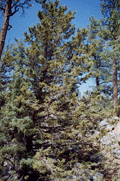
| 1
Cupressus montana
- Tree.
Baja California - Mexico
|
2
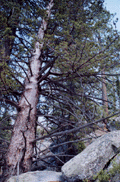
| 2
Cupressus montana
- Tree.
Baja California - Mexico
|
3
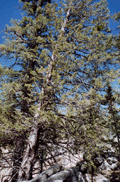
| 3
Cupressus montana
- Tree.
Baja California - Mexico
|
4
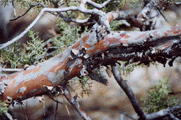
| 4
Cupressus montana
- Branch.
Baja California - Mexico
|
5
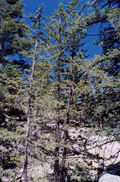
| 5
Cupressus montana
- Young trees.
Baja California - Mexico
|
6
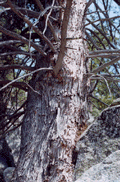
| 6
Cupressus montana
- Trunk.
Baja California - Mexico
|
7

| 7
Cupressus montana
- Trunk.
Baja California - Mexico
|
8
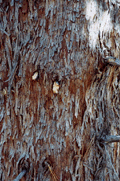
| 8
Cupressus montana
- Bark of mature tree.
Baja California - Mexico
|
9
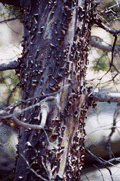
| 9
Cupressus montana
- Bark of a small tree.
Baja California - Mexico
|
10
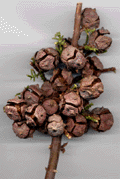
| 10
Cupressus montana
- Cones.
Baja California - Mexico
|
11
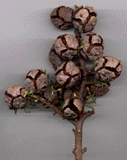
| 11
Cupressus montana
- Cones.
Baja California - Mexico
|
12
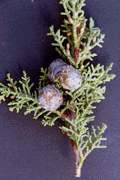
| 12
Cupressus montana
- First year cones
From a tree at the Sierra San Pedro Martir.
Baja California Norte - Mexico
|
13
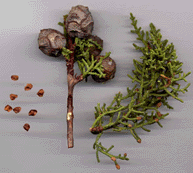
| 13
Cupressus montana
- First year cones, seeds and foliage.
From the Sierra San Pedro Martir.
Baja California Norte - Mexico
|
14
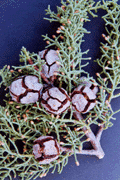
| 14
Cupressus montana
- Mature cones.
Sierra San Pedro Martir National Park.
Baja California Norte - Mexico
|
15
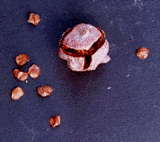
| 15
Cupressus montana
- Cone and seeds.
Sierra San Pedro Martir National Park.
Baja California Norte - Mexico
|
|